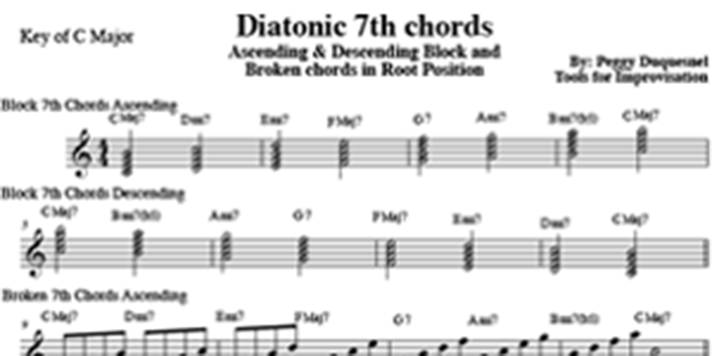Introduction
Diatonic chords are chords that naturally occur within a key. They contain only the notes found in the scale or key that you’re working in. There are seven diatonic chords in every key with each chord built from one of the 7 notes in the scale.
Download the PDF Exercise Sheet in C Major (Free)
Root Position
The chords in this exercise are all in root position, or built on the root of each scale tone of the given Major Scale. The first 3 tones of each chord is the basic triad, which is 3 – note chord stacked in 3rds when in root position. A student should become familiar with the diatonic triads first before embarking on studying the diatonic 7th chords in this hand out. 7th chords have four tones stacked in 3rds when in root position.
Block Chords
Block chords are when all of the chord tones are played simultaneously. This can only happen on chordal instruments such as guitar, piano, harp and vibraphone. Melodic instruments can play one part of the chord tone at a time and can divide up the block chords with other melodic instruments to hear the whole chord harmonically.
Broken Chords
Broken chords are when you play each individual notes of the chord melodically.
Ear Training
It is highly recommended that a student learn to sing the chord tones individually along with learning to play them on your instrument to develop and train the ear to hear the intervals and harmonies. Intervals are the distance between two notes.
Inversions
The next step to learning these chords is to learn the inversions of each chord. A chord inversion simply means rearranging the notes in a given chord. To invert a chord you move the lowest note or the bottom note up an octave.
Transposition
It is important for a student to learn these diatonic chord progressions and arpeggios in all 12 major keys so they can be applied to various chord progressions in different keys.
Application
The chords and patterns in this exercise can be used as tool for developing melodies for improvisation and for learning chord progressions and how they relate to the key signature. One great way to start is to play these exercises with a metronome to get fluidity and then experiment with developing some melodies using the chord tones and passing tones over diatonic chord progressions in the given key such as: I – IV – V7;
ii7 – V7 – IMaj7 or IMaj7 – vi7 – ii7 – V7. It is preferable to practice these with a live rhythm section or some sort of play along or accompaniment track.
Enjoy the process and have fun experimenting with new ideas!
Download the PDF Exercise Sheet in C Major (Free)
If you’ve enjoyed these exercises, you can download the remaining keys for $0.99. Get the Diatonic 7th Chord Exercises in all 12 keys here:
[template id=”182″]

